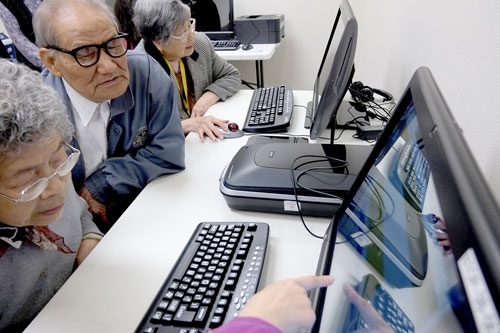Getting Older Americans Online
NTIA's Broadband Technology Opportunities Program (BTOP) is funding innovative programs across the nation that are working to close the digital divide. And a number of those projects are targeting a group of Americans too often left behind by today's fast-moving technology: seniors.
Broadband can improve quality of life for older Americans in many ways. Online videoconferencing technology can allow seniors to see grandchildren who live on the other side of the country. Medical websites can provide easy access to everything from health and wellness tips to information about illness and disease. Telemedicine and remote monitoring can enable elderly patients too frail to travel to consult with doctors at distant hospitals. Social media tools can combat isolation and even serve as a lifeline to the outside world.
What’s more, at a time when many Americans are working into their retirement years, Internet job listings and online employment applications – as well as Web-based training programs and classes - can help seniors retool for today’s economy.
But not enough older Americans are sharing in the benefits of broadband. NTIA, in collaboration with the Census Bureau, conducts some of the most extensive survey work on broadband adoption trends in the U.S. Our most recent published survey, in October of 2010, found that only 45 percent of U.S. households headed by someone 65 or older had broadband. That compares with 72 percent of households headed by someone ages 45 to 64, and 77 percent of households headed by someone ages 16 to 44.
BTOP is helping close this gap. Roughly 20 digital inclusion projects that receive funding through the Recovery Act program provide services targeted at seniors in some capacity. We’d like to tell you about three in particular:
- In New York City, the Department for the Aging has expanded and upgraded computer labs at 23 senior centers across the city. The program is part of the Connected Communities project, a BTOP-funded project run by the New York City Department of Information Technology and Telecommunications that is upgrading 80 existing computer labs and opening 10 new ones in libraries, public housing facilities, recreation centers and other community buildings across the metropolitan area. Many of these computer labs are located in low-income neighborhoods such as Harlem and the South Bronx. One key partner in the program, a non-profit called Older Adults Technology Service (OATS), is providing digital literacy and multimedia training for seniors at the BTOP-funded computer centers. OATS has also helped develop a new central computer center called the Exploration Center, which serves as a hub for training, curriculum development and technical support for 250 senior service agencies across New York City.
- In Northern Illinois, a company called Connected Living Inc. has opened computer labs in 23 affordable housing communities for seniors and people with disabilities. The BTOP-funded computer centers offer digital literacy classes and programming that cover everything from basic computer skills, such as mouse and keyboard navigation, to online search and social media tutorials. Housing residents who complete 12 training lessons and pass a skills assessment receive a new laptop to use while they live in one of the participating communities. The BTOP grant also provides for Internet service in residents' apartments. In addition, Connected Living is providing digital literacy training in surrounding communities in collaboration with Area Agencies on Aging, churches, senior centers, healthcare institutions and other community organizations. These programs are run by volunteers, and graduates have the opportunity to earn a refurbished desktop.
- In San Francisco, several city agencies led by the Department of Technology are using BTOP funds to provide digital literacy training for vulnerable groups, including seniors and people with disabilities. One centerpiece of the program, run by the San Francisco Department of Aging and Adult Services, has opened 53 computer labs in senior centers, city housing developments, adult daycare centers and other public buildings. Working in partnership with local non-profits and neighborhood organizations, the project is tailoring its services for San Francisco’s diverse communities. It is providing basic and intermediate computer and Internet training classes in languages including Spanish, Chinese, Korean, Vietnamese and Russian. The program also provides free access to specialized services such as TYZE.com, a Web tool that connects family members, friends, neighbors, doctors and others caring for an individual through a private online support network.
Through the valuable work of these three projects and other BTOP-funded programs, we are discovering a lot about the most effective strategies for increasing broadband adoption rates among seniors. Some key lessons:
- Interaction with patient, approachable trainers is critical for those who are new to computers and the Internet. Instruction often starts with explaining the basics: the mouse, the keyboard, the cursor.
- It is important to show older Americans why broadband is relevant to their lives – how it can help them connect with family and friends, refill a prescription or access government services, for instance.
- “Trusted intermediaries” – including family members, neighbors and even other seniors who have only recently mastered digital literacy skills themselves - can help break down fear and overcome intimidation among “tech timid” seniors.
- Locating computer labs and training programs in familiar, convenient, easily accessible settings – such as within senior centers – can increase participation among older Americans by removing barriers.
We hope these lessons will help guide others working to ensure that seniors can fully participate in today’s digital society. After all, perhaps the biggest lesson we have learned is that no one is too old to benefit from new technology.

